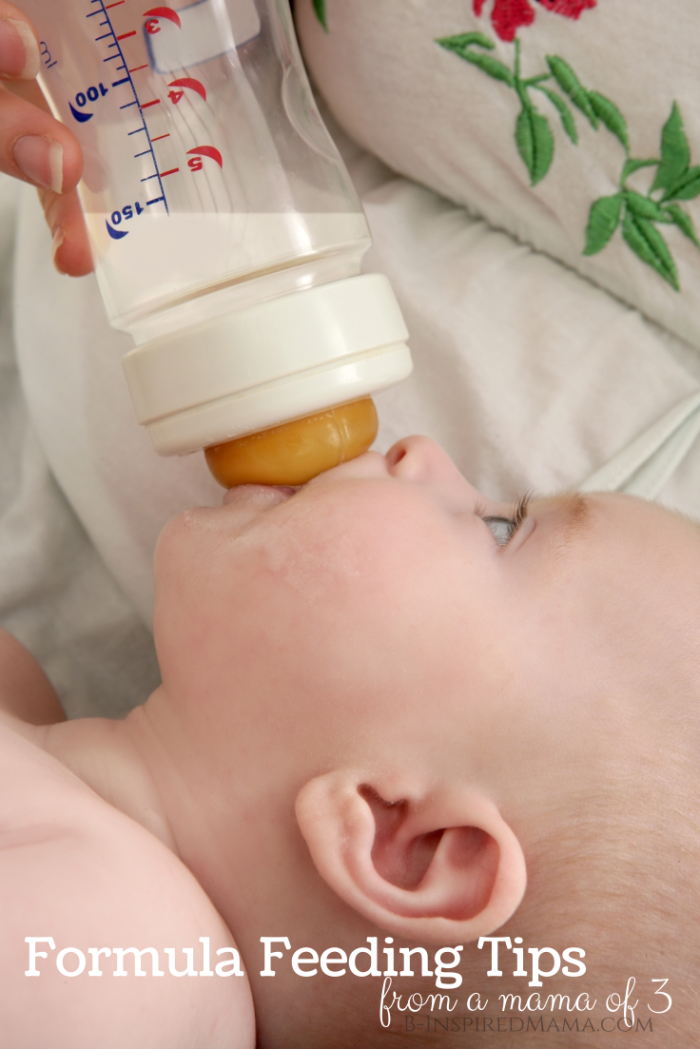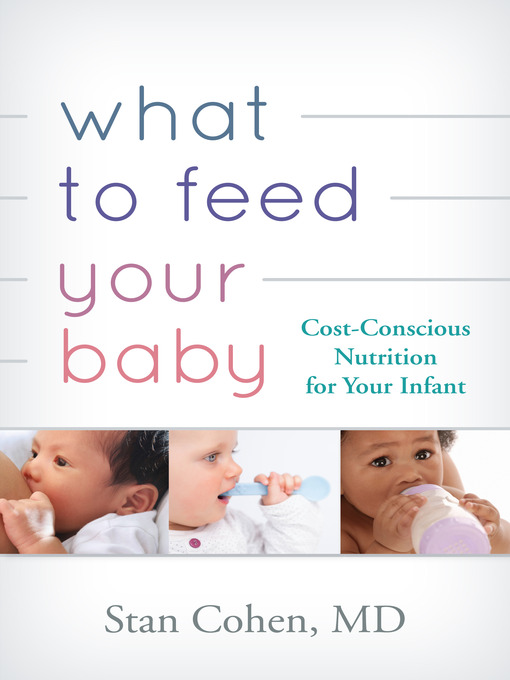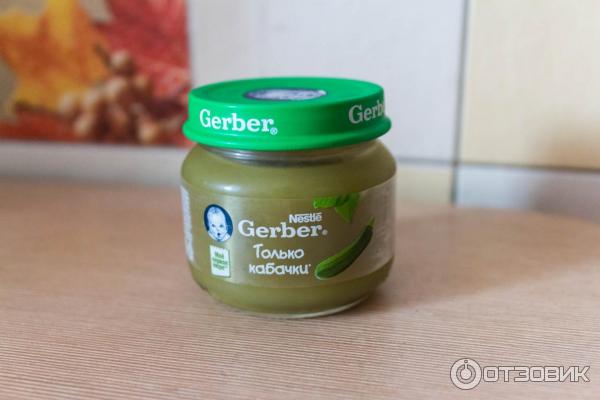Baby skin rash from food allergy
Does My Baby Have A Food Allergy Rash?
What is a food allergy rash, and what causes it? How do you know if your child has a food allergy rash? How to manage a food allergy rash, and how long does it usually last? We’ll cover everything families need to know about food allergy rashes in this definitive guide.
In our parent's guide to food allergy rashes, we'll answer the following most asked questions:
- What is a food allergy rash, and what causes it?
- How do you know if your child has a food allergy rash?
- What are the symptoms of a mild, moderate or severe allergic reaction?
- Where can food allergy rashes appear?
- How to manage a food allergy rash, and how long does it usually last?
- How do you test for a food allergy?
- How do you introduce allergens safely?
We’ll cover everything families need to know about food allergy rashes in this definitive guide.
What is a Food Allergy?
Normally, our immune systems protect our bodies from viruses, bacteria, and other foreign invaders that could harm us.
But when someone has a food allergy, their immune system mistakenly treats the proteins in a certain food (or foods) like these foreign invaders, and over-defends the body against these proteins. Their immune system makes special antibodies --- specific IgE antibodies --- that detect the food proteins and help fight them off.
These IgE antibodies trigger symptoms of an allergic reaction whenever the person eats a food they are allergic to. For example, if someone is allergic to peanut, they have IgE antibodies that detect and fight off peanut proteins, and that trigger allergic reaction symptoms (including a possible food allergy rash) whenever they eat peanuts.
Types of Food Allergic Reactions - Mild, Moderate, and Severe
Food allergy reactions can range from mild to severe, and can sometimes be life-threatening. Keep in mind, though, that a mild reaction can sometimes become severe. Also, symptoms of a food allergy reaction can vary from reaction to reaction. So, it’s impossible to predict what symptoms your child will develop each time they have an allergic reaction to food.
So, it’s impossible to predict what symptoms your child will develop each time they have an allergic reaction to food.
Symptoms of a food allergy reaction usually occur seconds to minutes after someone eats a food they’re allergic to, and almost always occur within a few hours of eating the food.
Symptoms of a mild or moderate allergic reaction may include:- A food allergy rash concentrated in one area of the body (red, raised bumps)
- Redness in an area of the skin
- Vomiting
- Swelling of the face, eyes or lips
- Itchiness
- Itchy, watery eyes
- Congestion
- Sneezing
- Some stomach pain
- Some nausea
- Mild coughing
- Worsening eczema
- A food allergy rash that spreads to many areas the body
- Swelling of the tongue
- Swelling or tightness of the throat
- Repeated, significant coughing
- Wheezing/noisy breathing
- Difficulty breathing /shortness of breath
- Change in voice or cry
- Struggling to vocalize
- Difficulty swallowing
- Repeated vomiting
- Pale appearance
- Diarrhea
- Dizziness
- Fainting
- Drop in blood pressure
- Rapid heartbeat
- Loss of consciousness
- Feeling floppy (infants/young children only)
Signs Of Anaphylaxis
When the symptoms of a food allergy reaction are severe and involve more than one organ system, the reaction is classified as anaphylaxis.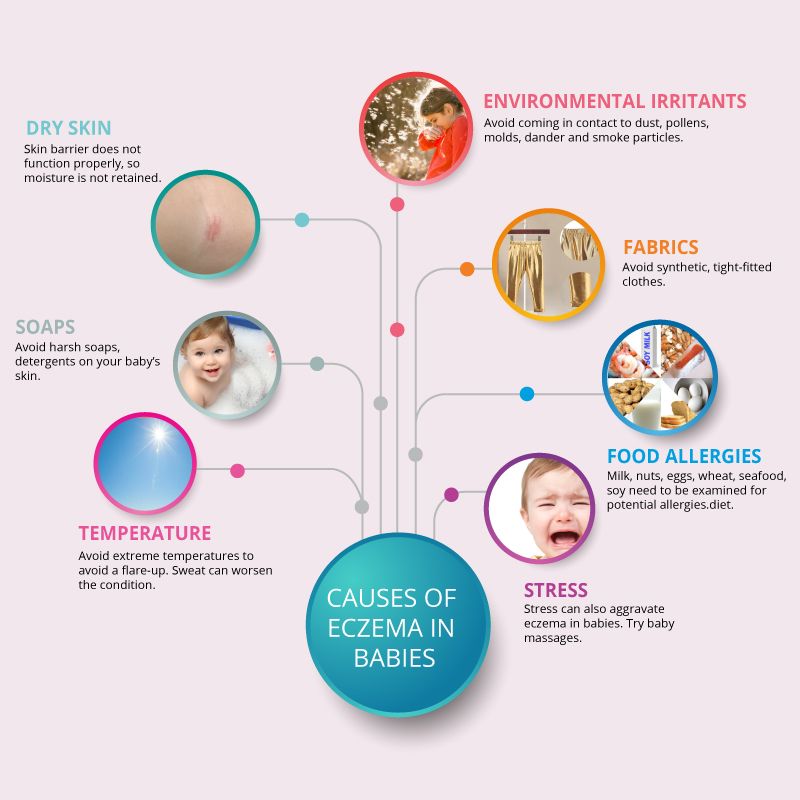 Anaphylaxis can be life-threatening. Call 911, and give epinephrine (use an Epi-Pen) immediately, if your child shows signs of anaphylaxis.
Anaphylaxis can be life-threatening. Call 911, and give epinephrine (use an Epi-Pen) immediately, if your child shows signs of anaphylaxis.
The National Institute of Allergy and Infectious Diseases (NIAID) provides more information on food allergy symptoms and management:
All About Food Allergy Rashes
A food allergy rash is the most common symptom of a food allergic reaction, especially in babies and children. It is also often the first symptom to appear (but not always). It could appear anywhere on the skin.
What does a food allergy rash look like?
A food allergy rash is raised, very itchy, and usually red or pink. It creates red, raised bumps on the skin. These bumps are usually rounded, and often have red flares around them.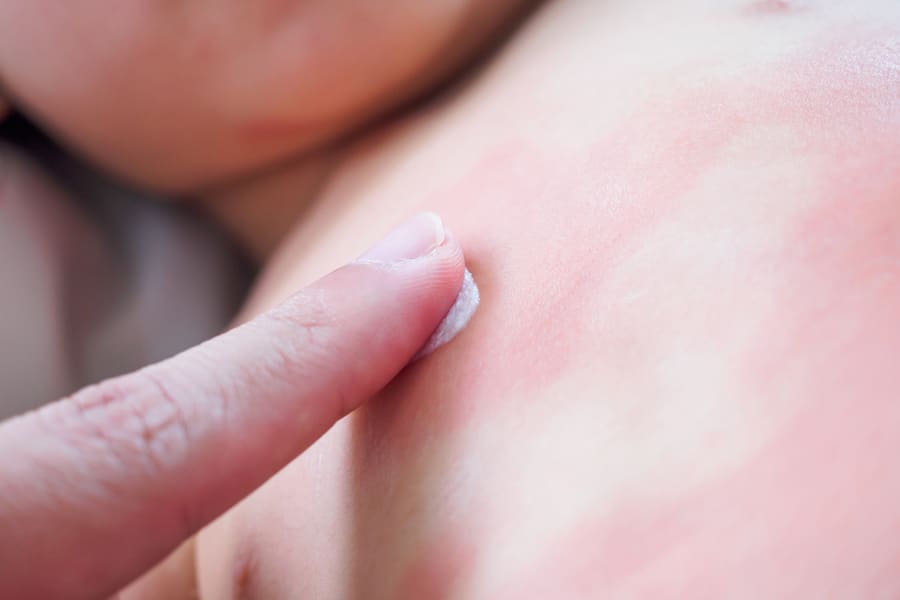 They are usually called hives, but are sometimes called wheals, urticaria or nettle rash.
They are usually called hives, but are sometimes called wheals, urticaria or nettle rash.
In people with darker skin, a food allergy rash will also appear as raised, itchy bumps. But often, the bumps do not appear red at all, and instead have the same color as the person’s skin is normally. You also probably won’t see red flares around the bumps. (In some cases, a food allergy rash may still have a subtle red hue, or a darker red hue, when it appears on a person with brown or Black skin.)
Why do food allergies cause a rash?When someone eats a food they’re allergic to, their IgE antibodies detect the proteins from that food. The IgE antibodies prime tissue cells (called mast cells) and blood cells to release a chemical called histamine, and other chemicals, as a way to defend against those proteins.
When the histamine and other chemicals get released, this causes blood vessels to widen (dilate) and become leaky. Fluids get released under the skin as a result, leading to inflammation under the skin. This leads to the raised food allergy rash on the skin.
This leads to the raised food allergy rash on the skin.
Food allergy rashes can be concentrated in one or two areas of the body, or can spread throughout the body.
Places that food allergy rashes often appear include the face, arms, hands, legs, feet, stomach area, and back. But they could appear anywhere on the skin.
Each individual bump (wheal) from the rash can be as small as a few millimeters or as large as several inches across.
But a rash area may be much larger, because food allergy rash usually appears as batches or clusters of bumps. And someone could develop multiple rash areas at a time.
If a food allergy rash is concentrated in one area, the food allergy reaction is mild. But if the rash spreads to many areas of the body, this is a sign of a severe allergic reaction.
How long does a food allergy rash last?Like other food allergy symptoms, a food allergy rash can appear seconds to hours after someone eats a food they're allergic to.
A food allergy rash usually lasts for several hours after food allergy reaction symptoms first appear. Sometimes, it can last for up to 24-48 hours.
Do all food allergy reactions produce a raised rash?Even though food allergy rashes are a common allergy symptom, they may not appear during every food allergy reaction. Sometimes, a food allergy can turn areas of the skin red and/or itchy, but won’t produce the raised food allergy rash (hives).
Also, a food allergy rash is different from the rash that eczema causes. But food allergies can make eczema rashes worse (cause eczema to flare up). Learn the differences between a food allergy rash and an eczema flare-up here.
How to Manage a Food Allergy Rash
If your child develops any food allergy rash (or any other food allergy symptoms), immediately stop feeding them the food that you believe was the cause of the reaction.
The other steps in managing a food allergy rash vary depending on how severe the allergic reaction is.
Managing a Mild Food Allergy Rash
How to manage mild food allergy rashes, concentrated in small clusters on one area of the body?
If a doctor has explicitly recommended a dosage of antihistamine, you can give your child the antihistamine (such as Benadryl or Zyrtec) to treat mild hives. Antihistamine helps stop the release of the histamine that triggered the rash, in the case of a mild or moderate allergic reaction.
If your doctor hasn’t recommended a dosage of antihistamine, call your pediatrician or allergist to alert them about the hives, and ask about next steps.
Either way, continue to monitor your child in case their mild allergic reaction turns severe.
Hydrocortisone cream may also help to relieve the itchiness of the rash, although it won’t make the rash go away.
Managing a Severe Food Allergy RashIf your child develops a significant food allergy rash all over their body, but no other symptoms of a food allergy reaction, call your doctor immediately.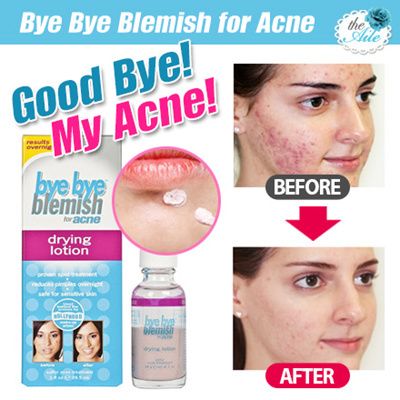
Continue to monitor your child for other symptoms of a food allergy reaction, because if other severe symptoms emerge, your child will have anaphylaxis. If you have epinephrine (an Epi-Pen), give your child an injection. An antihistamine will not be able to stop this severe, widespread rash.
If your child develops a food allergy rash all over their body, and it’s accompanied by severe symptoms in at least one other organ system, your child is experiencing life-threatening anaphylaxis and needs emergency assistance.
Inject epinephrine (an Epi-Pen) immediately, and call 911. Epinephrine is the only medicine that can stop anaphylaxis --- antihistamines cannot stop this severe reaction.
A Note About Food Allergic Reactions and Children
Many people wonder about the differences between food allergy reactions in children vs. adults.
Food allergy rash is one of the most common food allergy symptoms in children and adults. The way it appears in every age group is also largely the same.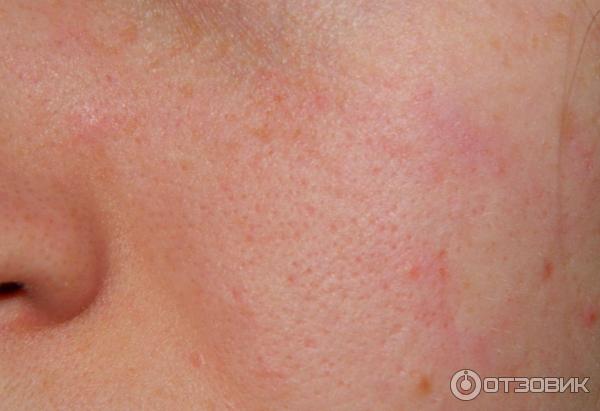 In fact, food allergies generally cause the same set of symptoms in children as they do in adults.
In fact, food allergies generally cause the same set of symptoms in children as they do in adults.
But even though food allergies cause similar symptoms across all age groups, the most common types of food allergies are different in children vs. adults.
In young children (5 years of age and younger), cow’s milk, egg, and peanut allergies are the most common food allergies. According to one study by Dr. Ruchi Gupta, these three foods are responsible for around 80% of food allergies in young children.
In addition to milk, egg, and peanut allergies, tree nut allergies are also very common in children age 14 and under.
Out of these four food types, peanut and tree nut allergies are most responsible for severe reactions in children, but any food has the potential to cause a severe reaction.
In contrast, the most common food allergy in adults is shellfish allergy, which is largely an adult allergy. Finned fish allergies are another common adult allergy --- and finned fish allergies also tend to develop in adulthood.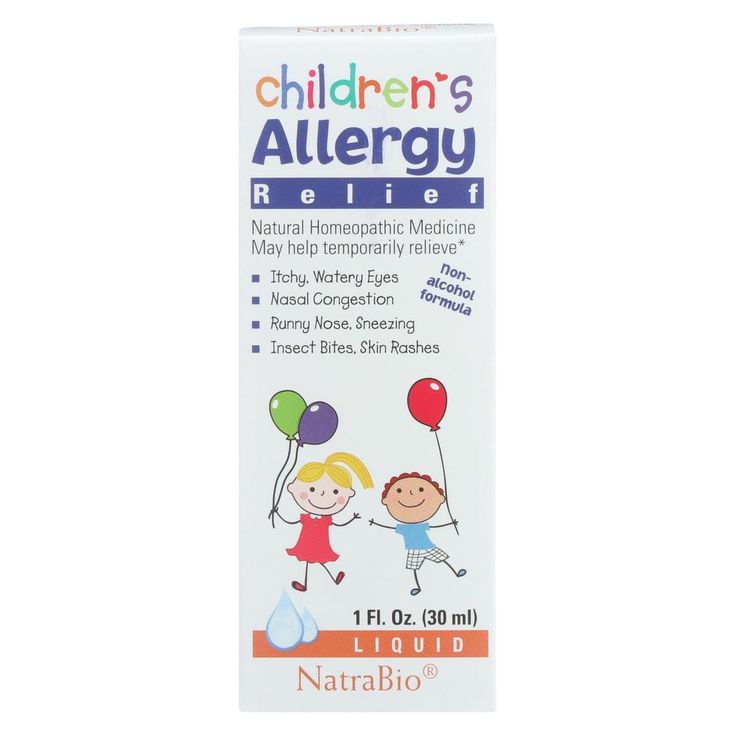
Check out our previous article for more on food allergies in children vs. adults.
Food Allergy Testing
If your child develops a rash after they eat a certain food, and it looks similar to the food allergy rash we’ve described above, remember that food allergy testing is the only way to determine whether your child truly has a food allergy. So, it’s best to make an appointment with an allergist for testing.
Food allergies can be diagnosed through three types of tests: a skin prick test, a blood test, and an oral food challenge.
A skin prick test: An allergist pricks your child’s forearm with a needle containing food protein from the suspected problem food. Then, they monitor your child to see if an allergic reaction develops around the area where their skin was pricked.
A blood test: An allergist checks your child’s blood for IgE antibodies that respond to certain food proteins.
An oral food challenge: Your child eats small amounts of the suspected problem food under an allergist’s supervision, to see if they develop an allergic reaction. This is the most accurate way to diagnose a food allergy.
This is the most accurate way to diagnose a food allergy.
Introducing Allergens Safely
New clinical guidelines recommend introducing babies to common allergy-causing foods during their first year of life, as a way to help them safely enjoy these foods in the future.
As the U.S. Department of Agriculture (USDA) recommends in their new dietary guidelines, “Potentially allergenic foods (e.g., peanuts, egg, cow milk products, tree nuts, wheat... and soy) should be introduced when other complementary foods are introduced to an infant’s diet.”
Ready, Set, Food! can help you easily and safely introduce these common allergy-causing foods to baby, following the new clinical guidelines. And since the first two stages of our system fully dissolve into a bottle of breastmilk or formula, you can start introducing your baby to peanut, egg, and milk as early as 4 months of age, even before they’re ready for solids.
All health-related content on this website is for informational purposes only and does not create a doctor-patient relationship. Always seek the advice of your own pediatrician in connection with any questions regarding your baby’s health.
Always seek the advice of your own pediatrician in connection with any questions regarding your baby’s health.
These statements have not been evaluated by the Food and Drug Administration. Products are not intended to diagnose, treat, cure or prevent any disease.
See the FDA Peanut Allergy Qualified Health Claim at the bottom of our homepage.
Does My Baby Have a Food Allergy Rash? — Prevent Food Allergies
Managing Food Allergies
Written By Jannie Huang
Do you think your baby’s rash may be caused by a food allergy? Let’s look at how to identify and treat a food allergy rash.
What is a Food Allergy Rash?
A food allergy rash is a rash that is caused by an overreaction of our immune systems to a particular food. Our immune systems are there to protect us from bacteria, viruses, and other invasions that can cause sickness.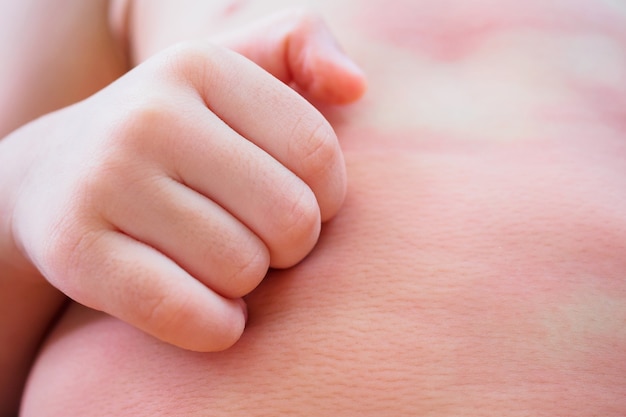 As is the case with other types of allergies, a food allergy occurs when the body reacts to an otherwise harmless item, wreaking havoc in our systems. With food allergies, the IgE antibodies overreact to a particular food(s), and a rash is often the first symptom to form.
As is the case with other types of allergies, a food allergy occurs when the body reacts to an otherwise harmless item, wreaking havoc in our systems. With food allergies, the IgE antibodies overreact to a particular food(s), and a rash is often the first symptom to form.
How do IgE Antibodies Cause a Rash?
IgE antibodies detect the food and release histamine into the bloodstream to offer protection from the otherwise harmless food. In the process, blood vessels widen and release fluid which causes inflammation under the skin. A raised rash is the result, leaving the baby uncomfortable and the parents wondering what caused it and where to go from here.
Identifying a Food Allergy Rash
One of the most common signs your baby may have a food allergy is a rash that appears shortly after eating the offending food. It is often the first symptom to appear, the most common symptom of a food allergy, and can appear anywhere on the skin.
A food allergy often presents itself in the form of hives.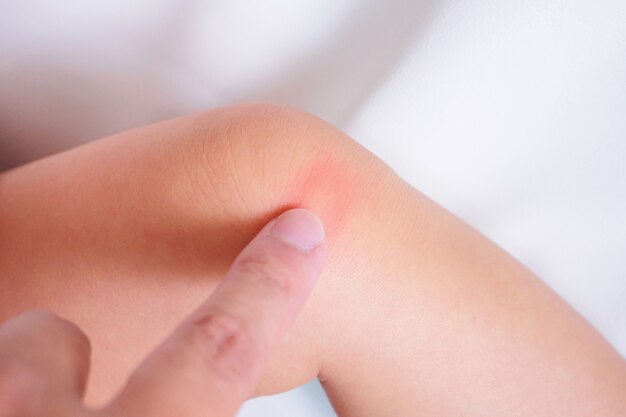 Food allergy rashes often are concentrated in a couple areas on the body but can spread to other areas, especially in the case of a more severe food allergy. The individual bumps are often small in size, but they cluster together to form larger areas that may look like one larger rash.
Food allergy rashes often are concentrated in a couple areas on the body but can spread to other areas, especially in the case of a more severe food allergy. The individual bumps are often small in size, but they cluster together to form larger areas that may look like one larger rash.
In some cases, a food allergy can cause the skin to become red and inflamed without actually causing an actual raised rash. Food allergies can also cause eczema to become worse. Though worsening eczema is not a rash, it is important to watch this type of symptom closely since it is often associated with food allergies.
Though a rash may be the only symptom, one of the best ways to identify food allergy rashes is to pay attention to other signs that might accompany them. These signs will almost always occur within a few hours of eating the food. If you notice any of the following symptoms, along with a rash, contact your doctor to help determine if a food allergy might be the cause.
Mild Food Allergy Symptoms
Nausea and vomiting
Swelling
Sneezing
Congestion
Stomach pain
Itchy, watery eyes
Coughing
Worsening eczema
Swelling of the tongue
Tightness of the throat
Coughing
Wheezing
Difficulty breathing
Shortness of breath
Paleness of skin
Fainting
Rapid heartbeat
Loss of consciousness
Anaphylaxis
Anaphylactic reactions are rare in babies under the age of one, but it is good to be aware of the symptoms. Anaphylaxis is a swift, intense allergic reaction that is life-threatening and requires immediate medical attention. If you notice any of the following symptoms in your child, seek medical help right away:
Anaphylaxis is a swift, intense allergic reaction that is life-threatening and requires immediate medical attention. If you notice any of the following symptoms in your child, seek medical help right away:
Difficulty breathing
Shortness of breath
Swelling of the tongue
Widespread hives, covering a large part of the body
Wheezing
Pale appearance
Fainting
Rapid heartbeat
Persistent coughing
How to Treat a Food Allergy Rash
A food allergy rash actually doesn’t last very long, oftentimes clearing up in less than 48 hours. It is important to keep track of what your baby ate prior to the rash forming so that you can revisit your list should another rash appear later. You may also want to start a food journal and continue to keep track of what your child eats in the coming weeks and months. This can help you determine if there are other allergies.
Even though rashes often go away on their own, they can be itchy and uncomfortable. Thankfully, there are some things that can provide relief.
Treating a Mild Food Allergy Rash
If your baby has a small rash that is confined to one area of his body and you suspect it was caused by food, you are most likely dealing with a mild food allergy. One of the best ways to treat a rash is with an antihistamine. Antihistamines block the histamine response, which helps clear up the rash. Be sure to ask your doctor about types and dosage before administering antihistamines to your baby.
You can also apply hydrocortisone cream to the area which will help relieve the itchiness. Hydrocortisone cream will not cause the rash to go away but can provide some relief.
Continue to monitor your baby in case the mild reaction turns severe.
Treating a Severe Food Allergy Rash
If your baby develops a widespread rash all over his body shortly after eating, you should call your doctor immediately.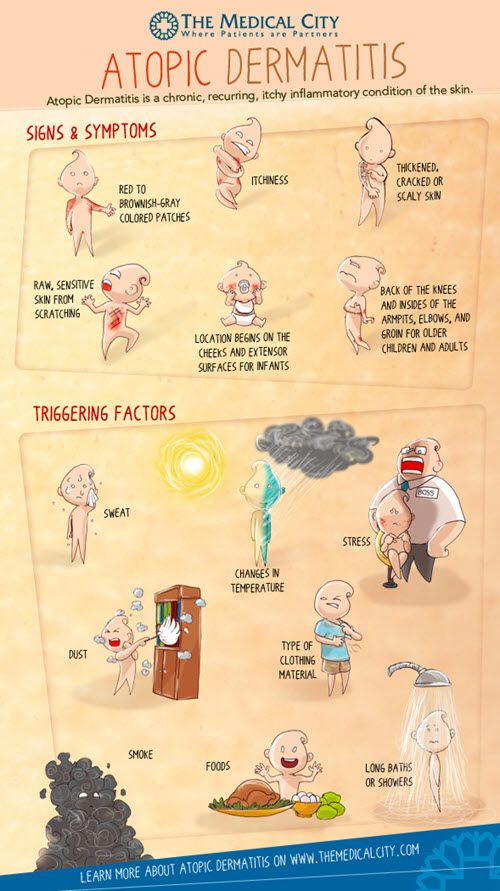 He could be experiencing an allergic reaction that can become life threatening if not treated right away. Continue to monitor your baby as you make your way to your doctor so you can inform the staff of other symptoms.
He could be experiencing an allergic reaction that can become life threatening if not treated right away. Continue to monitor your baby as you make your way to your doctor so you can inform the staff of other symptoms.
More About Food Allergies
Food allergies can develop at any time, though it is more rare to develop a food allergy late in life. Usually, they are detected early in childhood, when the child reacts to a certain food. As noted previously, often the first sign of a food allergy is a rash. If you suspect your child has developed a rash as a result of a food allergy, you may want to learn more about allergies and how to proceed safely.
Learn more from the Mayo Clinic on food allergic reactions:
YouTube Video: Mayo Clinic Minute: What happens to your body when you're allergic to food?
Allergies in Children vs in Adults
Both adults and children alike develop food allergies, though what they become allergic to often varies. Children are more likely to be allergic to cow’s milk, eggs, and peanuts, or tree nuts whereas the most common food allergens for adults is shellfish and finned fish. In either case, both adults and children are likely to develop a rash after eating an offending food.
In either case, both adults and children are likely to develop a rash after eating an offending food.
Peanut and tree nut allergies are more likely to cause serious reactions than the other allergies, but any allergy can become severe at any time.
Getting Tested for Food Allergies
The only way to determine if your child’s rash was caused by a food allergy is to make an appointment to undergo food allergy testing. Once you have talked to your doctor about possible causes for the rash and applied any acute medical care needed, you should make an appointment for your child to get tested for food allergies. There are a few ways this is done. You and your doctor will work together to determine the best testing for your child.
Oral Food Challenge
In this method of diagnosing a food allergy, your doctor will give your baby a small amount of the suspected food and watch him closely to see if he develops an allergic reaction.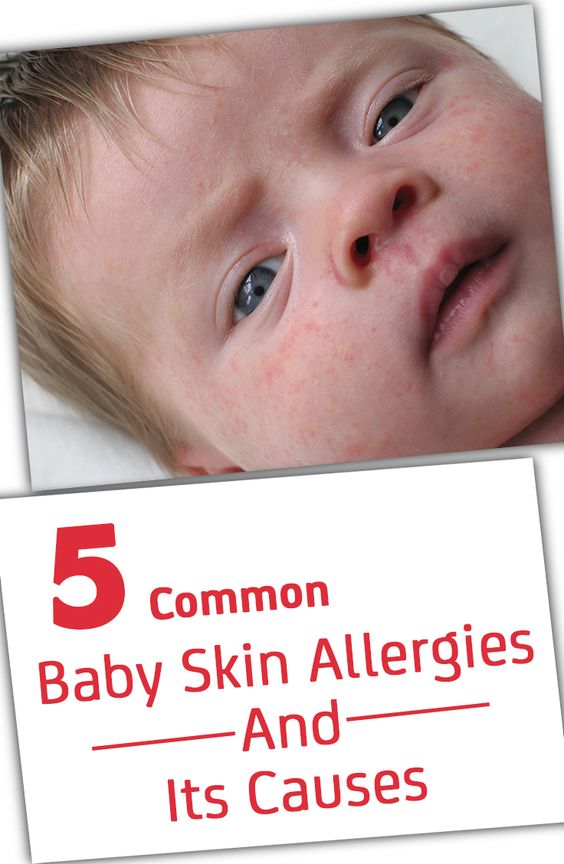 An oral food challenge is a safe, accurate method when used under the direct supervision of a doctor. This is the most accurate way to determine a true food allergy.
An oral food challenge is a safe, accurate method when used under the direct supervision of a doctor. This is the most accurate way to determine a true food allergy.
Skin Prick Test
During this test, your doctor will prick your child’s skin with the suspected allergen and watch to see if a rash develops around the area. Since a food allergy rash is often the first symptom of an allergy, this is a fairly accurate way to see if your child is allergic to a specific food.
Blood Test
When your child undergoes blood testing for allergies, your doctor will check for IgE antibodies in the blood. The presence of these antibodies will indicate an allergy to a specific food or variety of foods.
The Bottom Line
If your child develops a rash shortly after eating, you should take note of the suspected food and stop feeding to your child right away. You may want to start a food journal to monitor your child’s food intake and any potential rashes or other symptoms that might arise.
If the rash is mild and limited to one small part of the child’s body, you can treat it with antihistamines or with topical hydrocortisone cream after first discussing treatment options and dosages with your child’s doctor. If your child develops a major rash that is widespread, you should contact your doctor immediately and watch for signs of anaphylaxis.
Talking to your doctor about the rash is important both in the treatment of the rash and in discovering the cause. If you and your doctor think a food may be the cause of your child’s rash, you should continue to keep the suspected food away from your child and schedule allergy testing. There are a few different tests your doctor may use to determine if your child has a food allergy
Discovering your child has a food allergy can be a scary time for parents, but there are many ways to manage food allergies in children. Learning more about food allergies, their causes, signs, and symptoms, and management are all ways parents can be prepared.
--------------------------------
All health-related content on this website is for informational purposes only and does not create a doctor-patient relationship. Always seek the advice of your own pediatrician in connection with any questions regarding your baby’s health.
These statements have not been evaluated by the Food and Drug Administration. Products are not intended to diagnose, treat, cure or prevent any disease.
See the FDA Peanut Allergy Qualified Health Claim at the bottom of our homepage.
Jannie Huang
Food allergies in children - symptoms, treatments, diet its individual components. What are its causes, what are the risk factors, and what food to choose in case of an allergic reaction - read in this material.
Food allergy symptoms
The causes of food intolerance are related to the fact that the immune system "incorrectly" recognizes them as potentially dangerous, and produces protective antibodies in excess.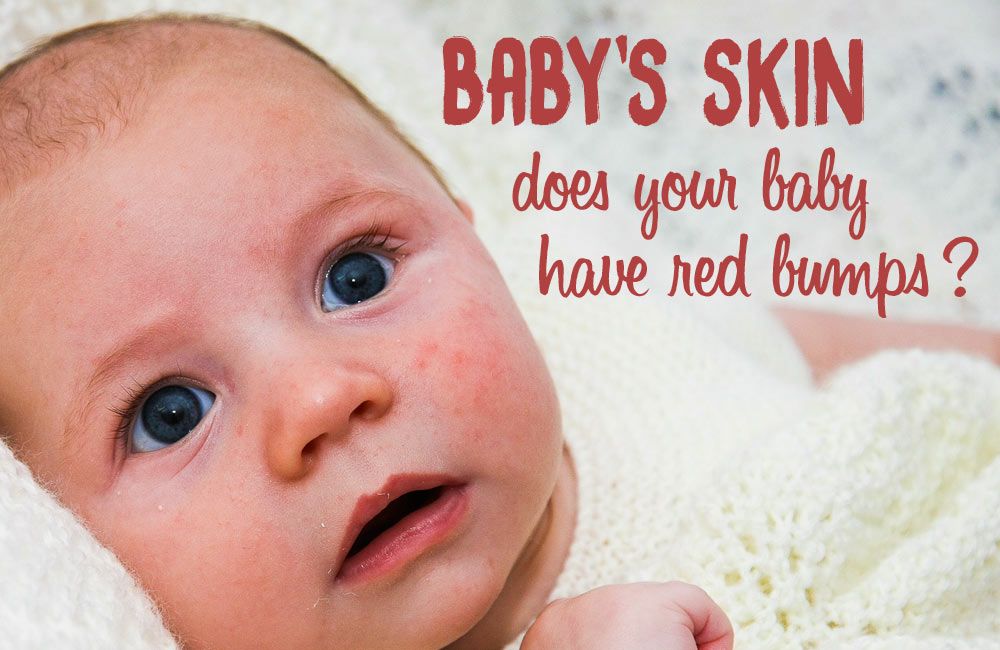 Excessively violent reaction leads to the fact that the child develops an allergy to certain types of food. 1.3
Excessively violent reaction leads to the fact that the child develops an allergy to certain types of food. 1.3
Symptoms of food allergy in children are different. But most often, food allergies manifest themselves on the part of the skin - itching, a feeling of tightness and dryness. Local swelling may occur on the skin, a rash (urticaria), redness, blisters may appear. In second place in terms of frequency of manifestation - reactions from the respiratory system. Runny nose, nasal congestion, sore throat, cough of varying intensity. Also, reactions from the organs of the gastrointestinal tract can indicate food allergies. A very young child begins to be disturbed by colic, dyspepsia, stool disorders from diarrhea to constipation. Older children complain of nausea, vomiting, abdominal pain, a feeling of scratching in the throat, behind the sternum.
Do not forget about the general symptoms of food allergies: the child becomes lethargic, capricious, sleeps poorly, does worse in school (or psycho-emotional development), is prone to daytime sleepiness.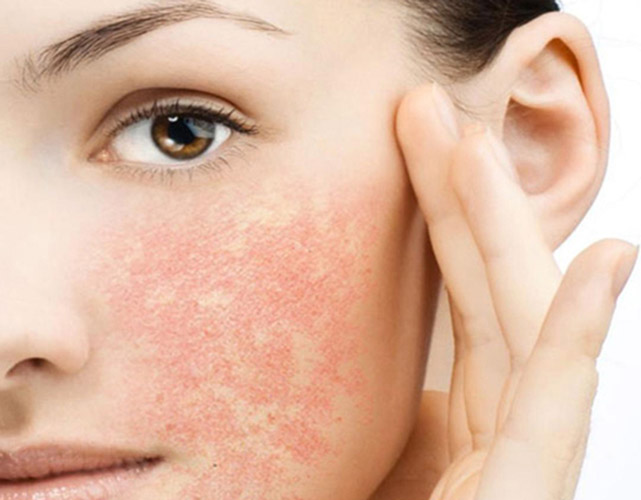 2.3
2.3
Causes of food allergies
Newborns and young children, if predisposed, may suffer from allergies due to their physiological characteristics. The fact is that a child is born with an immature gastrointestinal tract, the intestinal walls are permeable to many substances, the enzyme system is still imperfect. Therefore, it is difficult for the body to cope with the digestion of proteins. The body seems to be in a state of constant "combat readiness" and the ingestion of even a small amount of allergens leads to a response from the immune system and the development of a violent allergic reaction. 1.2
In older children, many internal and external conditions become risk factors. For example, heredity - after all, if one of the child's parents suffered from an allergic disease, then with a high degree of probability the child will also be given a tendency to it. Unfavorable environmental factors influence - polluted atmosphere, car exhausts, lack of green plants in cities.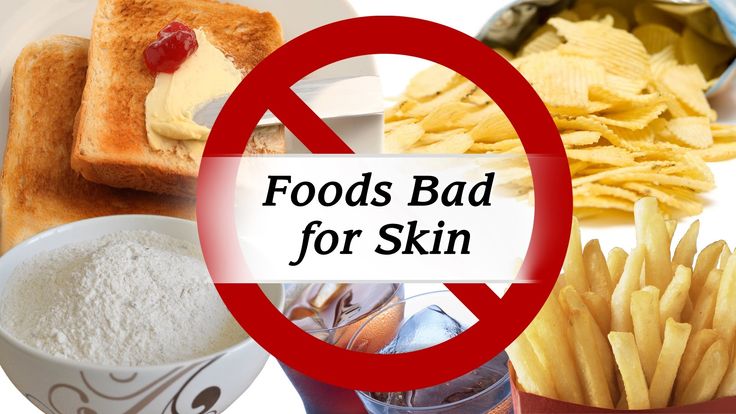 Very often, a violation of the immune system in the form of an allergic reaction occurs in children with a labile, mobile psyche, with sharp transitions from friendliness and calmness to crying and back. Finally, bad habits, both in children and mothers during pregnancy, become an important factor. This is incorrectly introduced complementary foods and early introduction of potentially allergenic foods into the child's diet: citrus fruits, nuts, chocolate, berries, honey, and, of course, the habit of children to eat only something tasty (usually unhealthy; chocolate, carbonated drinks, fast food ) 2,3,4
Very often, a violation of the immune system in the form of an allergic reaction occurs in children with a labile, mobile psyche, with sharp transitions from friendliness and calmness to crying and back. Finally, bad habits, both in children and mothers during pregnancy, become an important factor. This is incorrectly introduced complementary foods and early introduction of potentially allergenic foods into the child's diet: citrus fruits, nuts, chocolate, berries, honey, and, of course, the habit of children to eat only something tasty (usually unhealthy; chocolate, carbonated drinks, fast food ) 2,3,4
List of products that provoke allergies
Due to the extreme individuality of the immune system, it is almost impossible to predict its reaction. However, there is a rough list of foods classified into groups depending on their allergenicity - that is, the ability to cause a sharp reaction from the immune system and allergy symptoms. It is important to remember that it is not necessary that any product from the first column will cause a reaction. Like any low allergenic product, in some cases, it can cause an overreaction to it. 2,3,4
Like any low allergenic product, in some cases, it can cause an overreaction to it. 2,3,4
Examples of the most typical exoallergens
| Highly allergenic products | Foods of average allergenicity | Low Allergy Products | |
| all citrus fruits, strawberries, strawberries, raspberries, blackberries, pineapples. | peaches, cranberries, lingonberries, cherries, blueberries, black currants. | pears, gooseberries, dried apricots, plums, white currants, apples and pears. | |
| carrots, tomatoes, bell peppers, radishes. | potatoes, beets, peppers, peas, corn. | broccoli, green peas, zucchini, squash, white and cauliflower, cucumbers, pumpkin. | |
| eggs, sausages and sausages, chicken, sea fish. | beef, rabbit, pork. | lamb. | |
whole cow's milk, cheeses, yoghurts with additives. | fermented milk products. | ||
| wheat, rye. | buckwheat, oats, rice, peas, beans. | barley, millet. | |
| coffee, cocoa, chocolate, nuts, honey. | xylitol, fructose | ||
| mushrooms, carbonated drinks, packaged juices. | vegetable oil. |
Diagnosis established
The diagnosis of this allergy, as well as the search for the causes that caused it, requires a careful and serious approach on the part of parents. The younger the child, the easier it is to find foods that cause illness. For this, two conditions must be met.
The first thing is to put a child or mother on a hypoallergenic diet if she is breastfeeding - a detailed nutrition plan will be helped by an allergist together with a pediatrician. Please note that during an exacerbation, the diet will be extremely strict, the so-called elimination diet - aimed at removing the allergen and reaction products to it with the complete elimination of potential and cross allergens.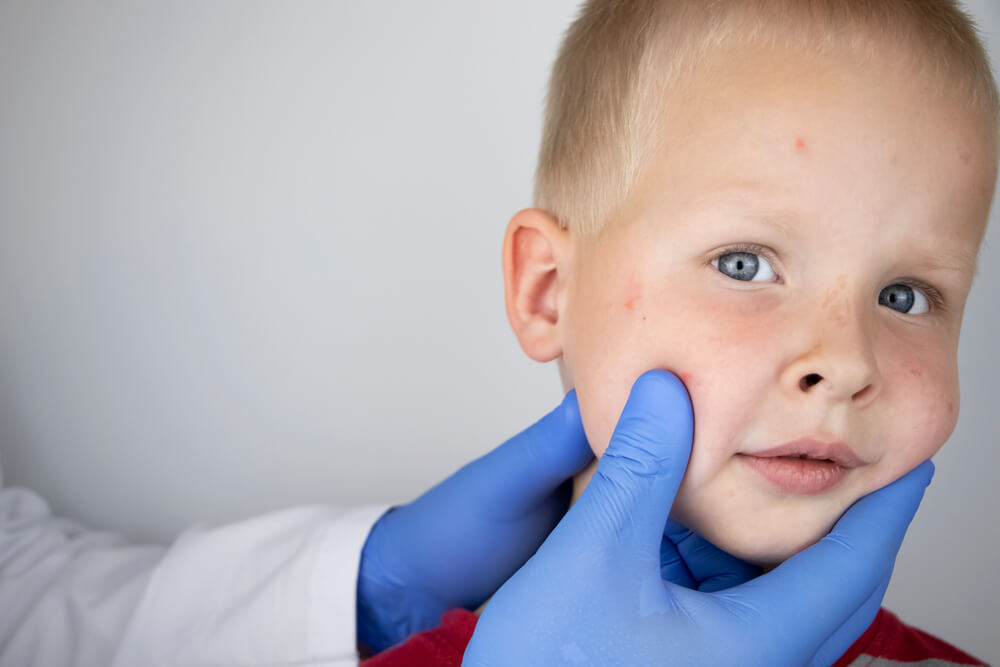 The duration of such a diet is determined by the doctor. When the exacerbation fades, the diet gradually expands due to safe foods. 3.4
The duration of such a diet is determined by the doctor. When the exacerbation fades, the diet gradually expands due to safe foods. 3.4
And the second is to start keeping a special food diary in which to record everything that was eaten and drunk by the child during the day, as well as what was prepared and how. At the first sign of an allergic reaction, suspicious foods should be eliminated one at a time (or from the mother's diet if the baby is breastfed). After elimination, within a few days, it is worth observing the reaction, if the manifestations of allergies decrease, then the product is really not suitable for the child - it should be avoided. If the child is very small, then the diary is kept according to the opposite principle: all foods that are introduced as complementary foods are recorded in it. The name of the product, the quantity, the time of eating and the reactions of the body are recorded over the next few days (the attending physician will determine the specific timing of observation).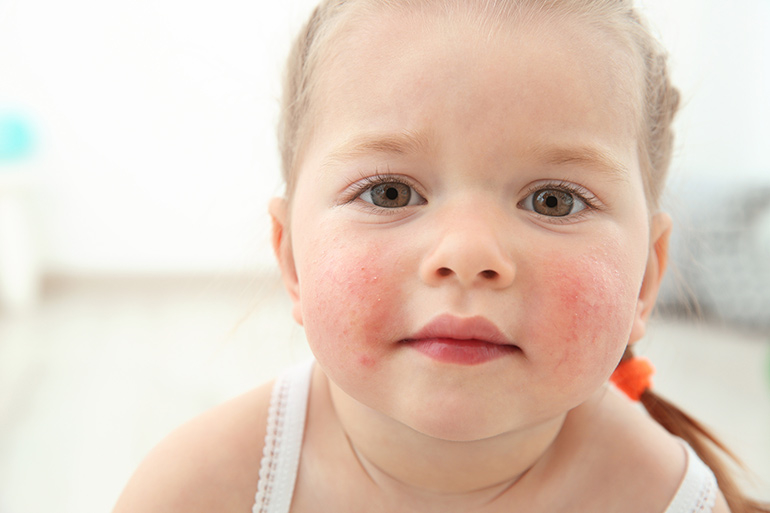 Next, the doctor will need to check and confirm the preliminary diagnosis by conducting special tests and analyzes.
Next, the doctor will need to check and confirm the preliminary diagnosis by conducting special tests and analyzes.
Emergency measures for food allergies
First, you need to assess the severity of the manifestations of food allergies.
For any symptoms, the first step is to avoid contact with a specific familiar allergen or any suspicious food or drink.
If the symptoms of allergy are mild - itching, redness of the skin, then you can give the child an antihistamine, which was previously recommended by the doctor for such cases. In addition, you must also call the local pediatrician and carefully monitor the condition of the child.
In case of obvious or possible signs of deterioration, call an ambulance. Signs that you should pay close attention to and immediately dial 03 include spreading rash and redness, increased itching, fever, drowsiness and lethargy, vomiting and nausea, refusal to drink water, difficulty breathing, loss of consciousness and pallor .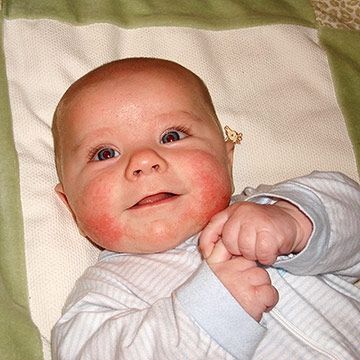
For general symptoms, in which it is difficult to understand whether they are associated with allergies or not, and which may indicate a developing serious condition, an ambulance should be called immediately if the child has any difficulty or changes in breathing, shortness of breath, cough, croup, vote. If pains in the abdomen began, extensive swelling, redness, itchy skin areas appeared. There is dizziness, fainting, as well as changes in the pulse - slowing or increased heart rate. 1,3,4
How to treat a food allergy in a child
Treatment depends on the stage of the allergic reaction process. With an exacerbation, antihistamines are prescribed that block histamine receptors, hormonal drugs. For skin manifestations of allergies, local preparations are used: creams, powders, etc. Respiratory reactions are treated with inhalation drugs and physiotherapy.
Good to know about ALLERGIC AND NON-ALLERGIC FOOD RESISTANCE (matvareoverfølsomhet)
ALLERGIC AND NON-ALLERGIC FOOD RESISTANCE
Food immunity is the body's hypersensitivity to certain food components. With food allergies, the body's immune defenses react to the proteins contained in food as dangerous "invaders". Even small particles of an intolerant product can cause an allergic reaction. As a rule, the reaction occurs immediately after the product enters the body and takes, in some cases, serious forms.
With food allergies, the body's immune defenses react to the proteins contained in food as dangerous "invaders". Even small particles of an intolerant product can cause an allergic reaction. As a rule, the reaction occurs immediately after the product enters the body and takes, in some cases, serious forms.
Other types of food hypersensitivity are not a reaction of the body's immune defense, but the symptoms may be similar to allergic symptoms. They depend on the amount of food eaten, occur a little more slowly and are less serious. The concept of "immunity" is used in cases where there is a reaction of the body to food, but the test results are normal. (There are many types of food hypersensitivity or, as it is often called, "food intolerance").
Prevalence of food allergy
About 5-8% of young children aged one to three years react to certain foods. Nationwide, about 5% of the population suffers from food allergies or sensitivities, including allergies that cross with pollen allergies.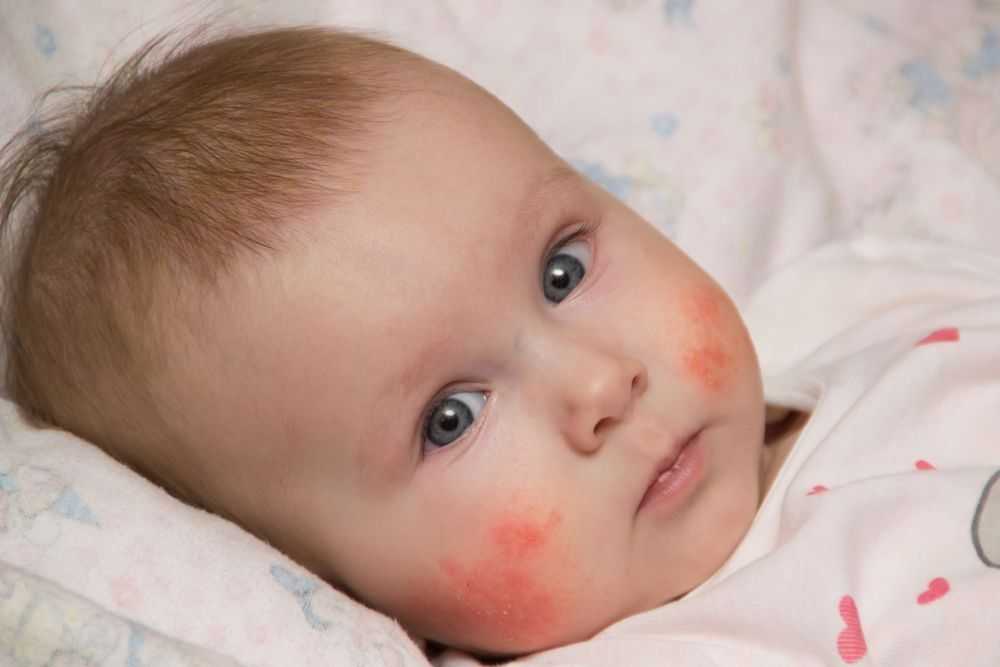 In addition, the problem affects many others due to the additional practical concerns for relatives and friends.
In addition, the problem affects many others due to the additional practical concerns for relatives and friends.
Common forms of food resistance
In young children, the most common allergies are to milk, eggs, fish, nuts, shellfish and legumes (peas, peanuts, beans, soybeans, lupins and lentils). Children suffering from atopic eczema are characterized by an allergic reaction to citrus fruits, strawberries and tomatoes. The intensity of the reaction depends on the amount of the allergen received and, most often, consists in the appearance of itching and an eczema rash.
In adolescents and adults, allergies to nuts (peanuts and hazelnuts) and shellfish and shellfish are common. In addition, there may be cross-reactions associated with pollen allergy to certain raw fruits and vegetables.
Allergy to wheat flour is less common, but can lead to severe allergic reactions in children. This type of allergy rarely occurs in adults. Children and adults suffering from intestinal disorders may complain of difficulty breathing, as well as increased pain in the stomach, after eating large amounts of foods containing flour, rye and barley.
There is also the possibility of an allergic reaction to wheat and other foods only in cases where the body is subjected to physical activity after eating. This type of allergic reaction can be difficult to identify.
Celiac disease is a disease of the small intestine, often referred to as gluten intolerance, in which proteins found in barley, rye, and wheat lead to intestinal inflammation. The treatment for celiac disease is a lifelong gluten-free diet.
Lactose intolerance is a lack of ability of the intestinal mucosa to process lactose (the sugar found in milk and dairy products). The symptom of lactose intolerance usually does not appear at an early age, until the age of 4-10 years. Lactose intolerance is not dangerous, but it is accompanied by abdominal pain, bloating, and diarrhea after taking large amounts of milk sugar.
Symptoms
The reaction can be moderate and short-term, or severe, sometimes life-threatening. Itching in the mouth and larynx with swelling of the mucous membrane is called oral allergic syndrome, which is typical of a cross-reaction to food and often occurs in individuals suffering from pollen allergies.
Common symptoms of a gastrointestinal reaction are bloating, pain, diarrhoea, nausea and vomiting. Also common, especially in young children, are skin reactions such as hives, increased eczema, and itching. Anaphylactic shock is rare but requires emergency medical attention. Its symptoms are swelling of the larynx, breathing problems, often vomiting, with a possible drop in blood pressure and loss of consciousness.
Diagnosis
Diagnosis is usually based on Pirquet and blood tests. These tests alone are not sufficient for an accurate diagnosis and in most cases must be combined with food control. Without an accurate diagnosis, foods important to the body should not be excluded from the diet. This is especially important in cases of suspected celiac disease, where the diagnosis is almost impossible to make without a gluten-free diet. During the control period, you can exclude suspicious foods from the diet for a certain period, and then gradually introduce them back into the diet.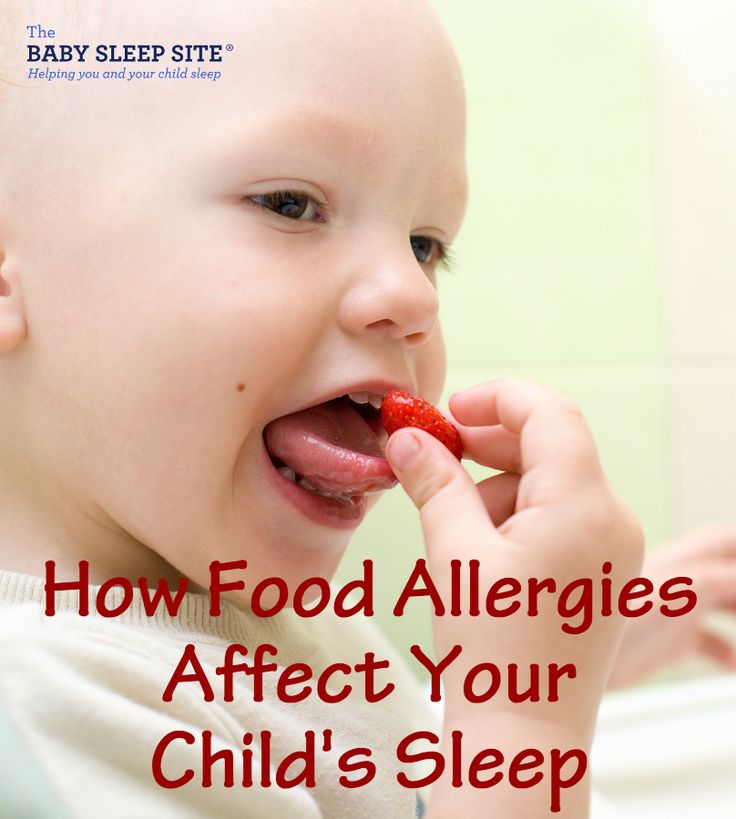
There are good methods for diagnosing celiac disease and lactose intolerance. However, in conventional medicine there is no single test that can establish general food hypersensitivity. In the field of alternative medicine, such tests are offered, but their correctness is not documented.
The Children's Clinic in Voksentoppen (Barneklinikken Voksentoppen) at the Rikshospitalet HF is a specialized hospital for children with allergies. There are no such specialized medical institutions for adults. They should first contact their local doctor, who can then make a referral to a specialist. For example, to a specialist in diseases of the gastrointestinal tract, lungs or an otolaryngologist.
The Regional Centers for Asthma, Allergy and Hypersensitivity handle complex case histories.
Treatment
The only treatment for food allergies is to eliminate intolerant foods from the diet. Most often, the most reliable way is self-cooking. Read the list of ingredients carefully when using prepared products. When visiting restaurants and catering places, it is important to clarify the content of dishes, as well as to inform in advance about allergies or hypersensitivity to certain products.
When visiting restaurants and catering places, it is important to clarify the content of dishes, as well as to inform in advance about allergies or hypersensitivity to certain products.
Proper selection of nutrition is very important, especially in childhood. Nutrients found in excluded foods need to be replaced. With milk allergy, care must be taken to ensure sufficient intake of calcium, iodine and vitamins B. It should be ensured that young children receive sufficient amounts of protein.
Children (under 3 years of age) who are allergic to cow's milk should be given a complete cow's milk substitute (available from a pharmacy with a prescription). When following a diet with the exclusion of wheat flour from the diet, it is necessary to monitor the receipt of a sufficient amount of proteins, fibers and minerals. Avoiding many fruits and vegetables can lead to a lack of vitamin C in the body. Your doctor may refer you to a specialist physiologist for individual nutritional advice.


